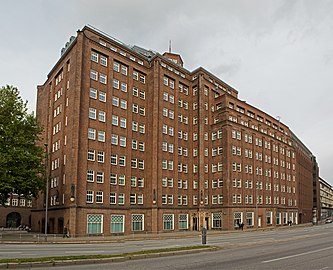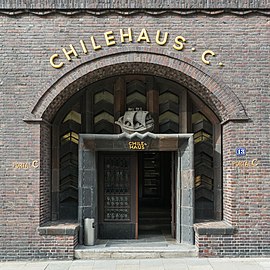Willkommen in Hamburg!
Germany’s second largest city, Europe’s third largest port, prosperous Hamburg is both a vibrant metropolis and one of the 16 Länder (federal states) that make up the Federal Republic of Germany. Its prestigious past can be read as you travel through the city, a mosaic of Belle Époque bourgeois architecture and town planning specific to industrial port areas, flourishing from its lively historic center. Its metropolitan dimensions and its rather provincial lifestyle make it very endearing.
To locate this city, we are in northern Germany, not very far from Denmark. Hamburg has the particularity of hosting a huge port, the third in Europe. But the big port cities, perhaps because they are growing open to the world, often have something interesting to tell. Its full official name Freie und Hansestadt Hamburg comes from the fact that it was part of the Hanseatic League in the Middle Ages.

Descending, from top: view of the Binnenalster, Elbphilharmonie, Speicherstadt, Elbstrand in Altona, Alsterfleet und Alsterarkaden, Hafencity; Hafencity – Containerterminal Burchardkai, and Port of Hamburg. own, CC BY-SA 3.0, via Wikimedia Commons
Alster River
To take a walk and breathe a breath of fresh air, a walk along the Alster river is perfect and of great beauty. Come for a walk with family or friends, enjoy a little coffee, watch the barges and enjoy the breathtaking view of the river and the fountain in its center.
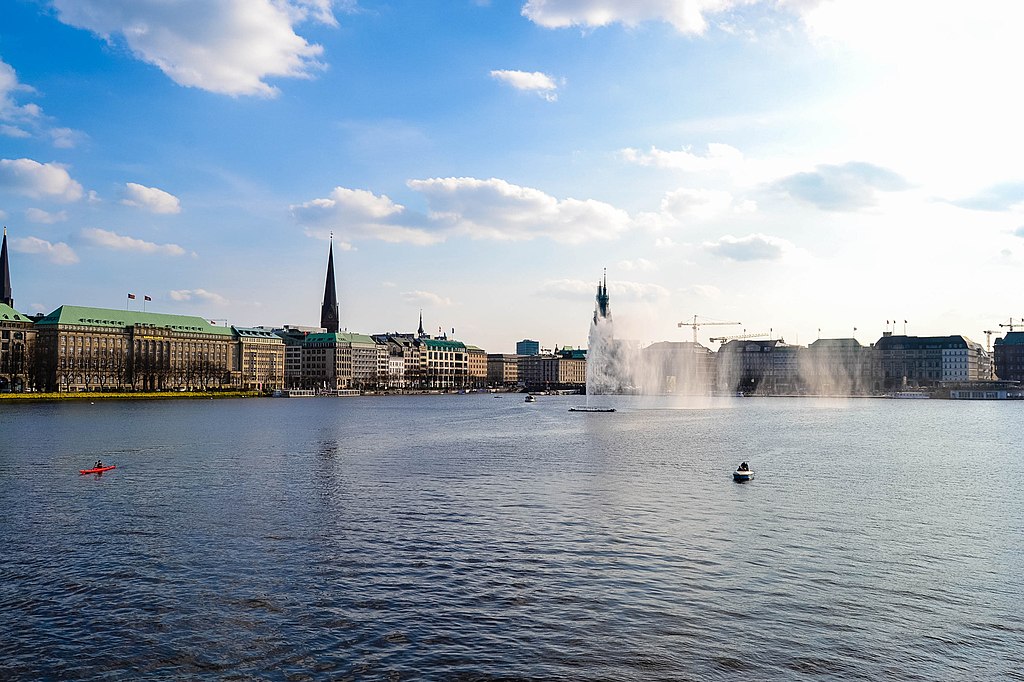
Alster river. Tobias Spitaler, CC BY 3.0, via Wikimedia Commons
City Hall (Rathaus)
It is situated in the Altstadt district in the city center, near the Binnenalster lake and the central station . Built between 1886 and 1897, the town hall still houses its government functions, with the office of the Mayor of Hamburg and the meeting rooms of the Hamburg Parliament and Senate.
The City Hall is open Mon — Sun from 8 AM to 6 PM, with several guided tours available to visitors. The Rathausmarkt in front of the City Hall is a popular venue for fairs, markets and concerts.

City Hall. Bernhard Hanssen, CC BY-SA 4.0, via Wikimedia Commons
Kontorhaus district, part of the Altstadt, well placed on the UNESCO World Heritage List.
between Steinstraße, Meßberg, Klosterwall and Brandstwiete. The street landscape is characterized by large office buildings in the Brick Expressionism style of the early 20th century.
Since 5 July 2015, parts of the Kontorhaus district and the adjacent Speicherstadt district have been placed on the UNESCO World Heritage List.
Mos famous buildings at Kontorhaus district
Chilehaus: was designed by architect Fritz Höger and built between 1922 and 1924. It owes its name to its owner, the shipowner Henry B. Sloman, who owed his fortune to trade with Chile : saltpetre . The building is considered the architect’s main work and one of the most important buildings of expressionism in clinker bricks.
Helmut-Schmidt-Haus: (press house until January 7, 2016), where several publishers used to work. Die Zeit still has its editorial office there today. It was built in 1938 based on a design by Rudolf Klophaus for the Nazi newspaper Hamburger Tageblatt. The company emblem, a Hanseatic cog by Richard Kuöhl, can be found – now without the swastika – on Curienstrasse.
HafenCity
HafenCity is the symbol of European resurrection in urban planning. It is also a young district that wants to be rich and attractive. Between parks, museums and restaurants, you will witness the most incredible of births.
We particularly recommend that you visit the “Elbphilharmonie” concert hall, which in itself is a true masterpiece. It has a 5-star hotel in addition to two rooms with 250 and 550 seats. Everything is installed on a red brick warehouse. Do not miss this place!

Sailing ships in Traditionsschiffhafen at Sandtorkai in HafenCity. Pedelecs by Wikivoyage and Wikipedia, CC BY-SA 3.0, via Wikimedia Commons
Concert hall Elbphilharmonie, in the HafenCity quarter
It is one of the largest and most acoustically advanced concert halls in the world. It is popularly nicknamed Elphi. The Hamburg philharmonic, designed by the famous architects Herzog and Demeuron, from Basel, is an absolutely fabulous work, a must see and as part of a guided tour if possible, with lots of interesting details. This is one of the must sees in this very friendly town.
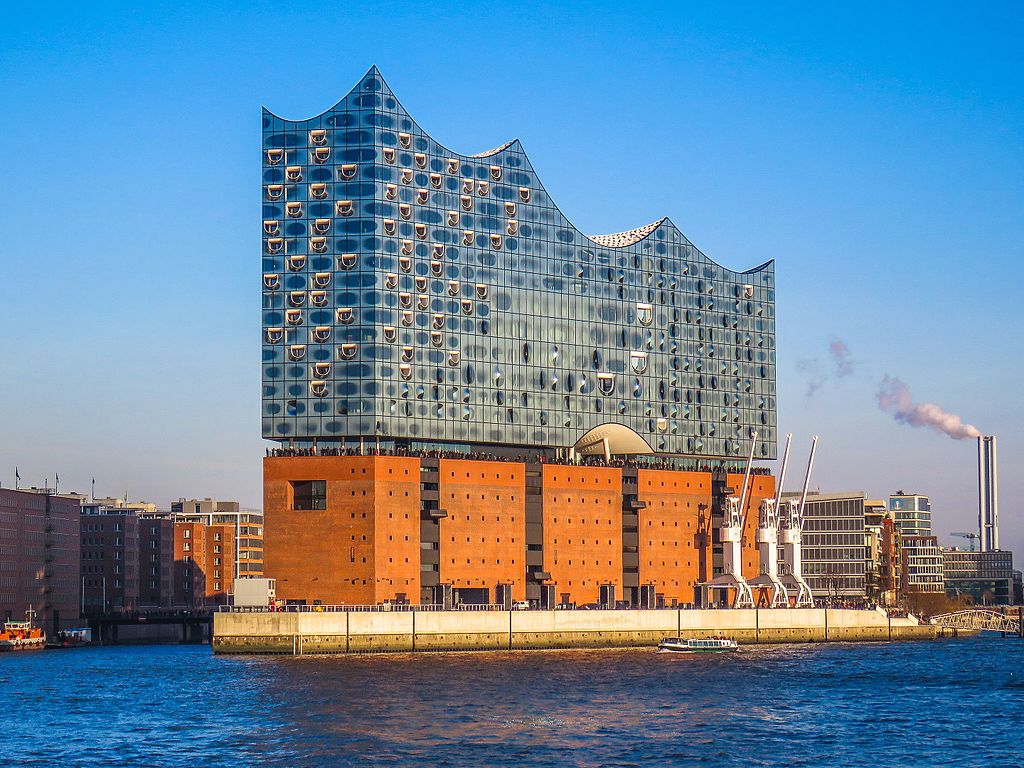
Elbphilharmonie, view from the Elbe river. Elbphilharmonie in 2016. Hamburg’s futuristic concert hall is often compared to Sydney’s iconic Opera House – and linked to the same huge cost overruns and construction delays as its Australian counterpart. It was inaugurated on 11 January 2017. Hackercatxxy, CC BY-SA 4.0, via Wikimedia Commons
Speicherstadt “warehouse town”
This name means “warehouse town” in German. The Speicherstadt district is perfect for night strolls because this is the time when you can appreciate the contrast of the dark red color of the bricks and the black of the windows illuminated by the city lights. You can also take a trip on the canals, visit the dungeons or the spice museum.
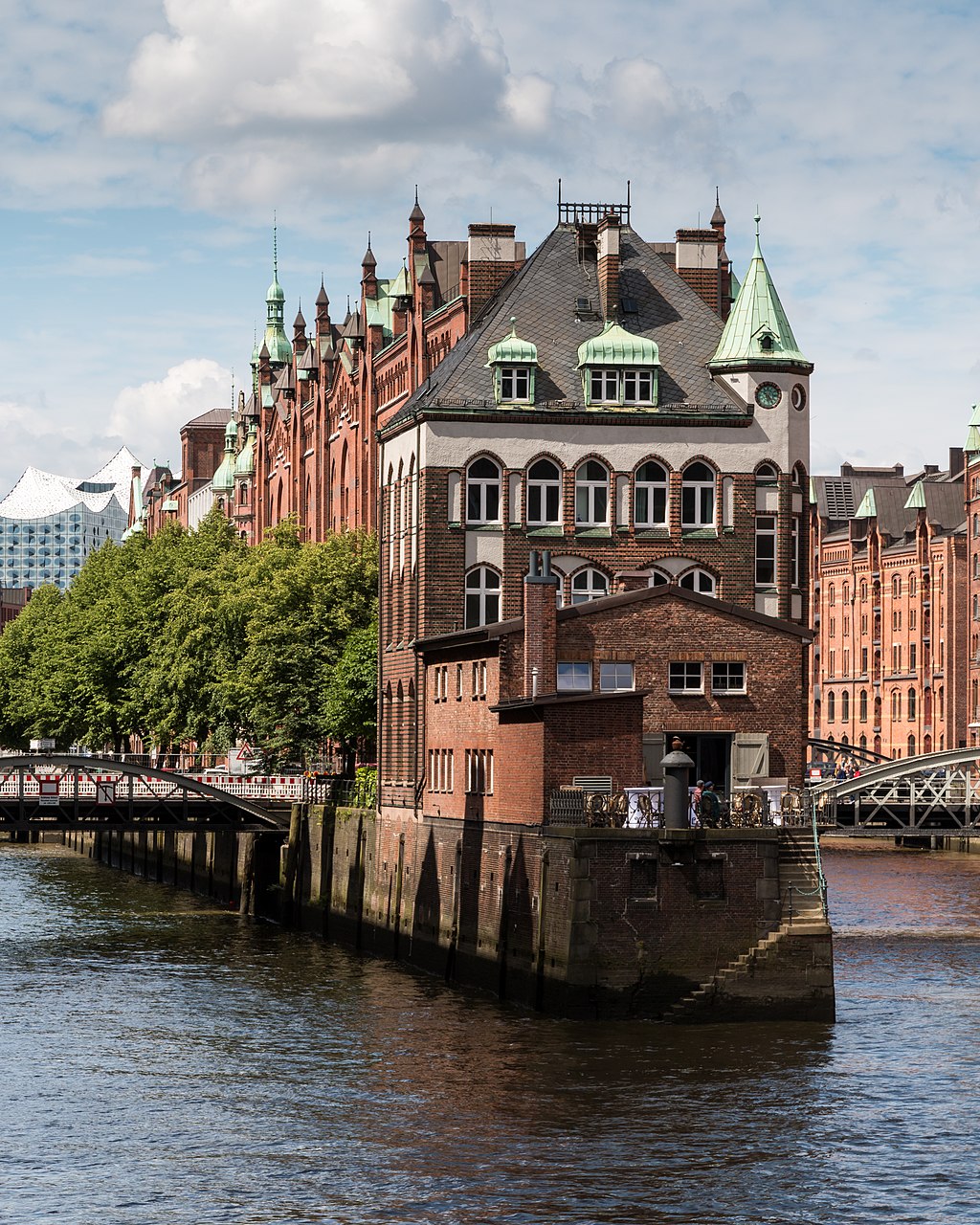
Water castle at Wandrahmsfleet (and Dutch Brookfleet (left)) in the Speicherstadt, Hamburg, Germany. Dietmar Rabich / Wikimedia Commons / /
Listed as a UNESCO World Heritage Site, the Speicherstadt is an exceptional testimony to the city’s port history
There is no doubt that the “warehouse city” is one of the most fascinating places in Hamburg. This set of huge red brick warehouses, aligned in a street layout over 370,000 m², was built between 1883 and 1927. Mounted on a million oak piles, the Speicherstadt and its huge red buildings offer an admirable spectacle to the heart from the city. This district in its own right was built on 26 hectares and on several islands linked together by seven canals. We walk there between streets, canals and bridges.
This city within a city
This city within a city, located in the former free zone of the port, forms the largest complex of warehouses in the world. It is now classified as a historic monument and became a UNESCO World Heritage Site in July 2015. It was here that the foodstuffs of Hamburg’s first major industrial port were initially piled up, before the developments of the second half of the 20th century. An outlet for coffee and spices, the Speicherstadt has become for ten years a tourist window of the city and a fashionable place. Museums have multiplied, cafes have opened. We find there in particular the Miniatur-Wunderland or the Hamburg Dungeon.
Now that the municipality gives the Speicherstadt a “little” sister, the HafenCity, the Speicherstadt is more than ever a synthesis between history and emblematic postmodernism of the city. For a long time, it was not possible to live there because of the violent and very frequent floods; but the recent construction of high bridges, which allow access for relief in case of danger, has made possible the development of dwellings and hotels on the top floors of some of the warehouses. Part of the premises is also occupied by offices. Be that as it may, the warehouses have not lost their utilitarian function for the moment, since 40% of them are still employed as such.
A striking experience in this furiously emblematic district
You can see the buildings from the canals on a harbor tour, and stroll the Kehrwieder Brook and Santorkai, jam-packed with oriental rug warehouses that can be visited for free. Also go to the Poggenmühlen-Brücke, where two canals meet, to contemplate the most beautiful view of the district on the Speicherstadt water tower and the Elbphilharmonie. A striking experience in this furiously emblematic district of the city, which is also free! One of the most essential visits to the great German port city.
Wasserschloss Hamburg
The Wasserschloss Hamburg in the Speicherstadt, a must visit place.
Regardless of whether you are a tea admirer or a newcomer, the Hamburg moated castle in the Hanseatic city amazes young and old alike. It enchants die-hard Hamburgers and tourists alike every time they set eyes on its glamorous exterior, day or night. Surrounded by historical storage buildings and located directly between two canals in the former free port zone, the moated castle is one of the most popular photo motifs in Hamburg. Have you seen it yet?

The Wasserschloss, also known as the Wasserschlösschen, is a historic building in Hamburg’s Speicherstadt. It lies on a peninsula in an exposed position between two canals: at the confluence of the Wandrahmsfleet and the Holländischbrookfleet. The official address is: Dienerreihe 4, 20457 Hamburg. The street Dienerreihe connects the streets Alter Wandrahm and Brooktorkai. The nearest subway station is Messberg. The moated castle has been a listed building since 1991. Kalle Kompakt, CC BY-SA 4.0, via Wikimedia Commons
The Wasserschloss Hamburg is now an enchanting tea office with its own gastronomy. The outdoor area facing the Fleet is particularly recommended. But don’t be alarmed, the Hamburg launches regularly honk their horns here.
Address Wasserschloss Hamburg:
Dienerreihe 4
20457 Hamburg
Website: https://wasserschloss.de/
Hamburg Water Palace opening hours:
Monday – Sunday
09.00 – 22.00
Metro station: U1 to Messberg
Museum of Fine Arts Hamburg Kunsthalle
The Museum of Fine Arts (Kunsthalle) in Hamburg presents on an area of 12,000 m² one of the most important art collections in Germany. Many internationally renowned temporary exhibitions are organized each year. The Hamburg Kunsthalle has a superb collection of paintings from all periods in store for you in a neo-Renaissance setting.
In the museum you can admire paintings of the characteristic painting of North Germany of the 15th century with its Hanseatic influence, but also old painting, impressionists and modern and contemporary art, as well as sculptures from the 19th and 20th centuries.
Highlight of the museum
A highlight of the museum is the romantic painting of the 19th century with 14 works by the painter Caspar David Friedrich, the best known of which, La Mer de Glace and Le Voyageur Contemplating a Sea of Mist. Among the works of the old masters, the altarpiece of Master Betram (1379). The 17th century is notably represented by works by the famous Dutch painter Rembrandt. Since its expansion in 1997, the gallery of the present (Galerie der Gegenwart) presents works from 1960 to the present day with an entire hall dedicated to Joseph Beuys.
We continue through the room of the Old Masters, devoted to medieval religious imagery, where we can contemplate the altarpieces and triptychs of the Church of Saint Peter in Hamburg, in particular the impressive altarpiece by Bertram von Minden.
The museum has a large collection of works of German Romanticism. The artist Otto Philipp Runge, who worked a lot in Hamburg, is one of the precursors. In the room dedicated to him, the eye is torn between the sentimentality of his allegorical paintings and the accuracy of his portraits and self-portraits. A little further on, don’t miss the Caspar David Friedrich room, where you can stop for a moment in front of the famous masterpieces of the romantic artist, in particular The Sea of Ice (La Mer de glace), and the other landscapes mystics, sunsets and ruins. The Traveler above the sea of clouds will immerse you in a moment of contemplation. It is the centerpiece of the museum, a work known throughout the world.
The room devoted to Impressionism is particularly beautiful and contains a few masterpieces. French visitors and lovers of Impressionism will undoubtedly be moved by Edouard Manet’s famous Nana and paintings by Monet (such as the Waterloo Bridge), Renoir, Degas or Cézanne. As for German Impressionism, it is the Berlin painter Max Liebermann who is the most represented.
The Sea of Ice (German: Das Eismeer) by Caspar David Friedrich
The painting depicts a frozen sea. The blocks of ice that compose it protrude towards the sky, while presenting a sharp appearance. The stern of a wooden ship caught in this sea of ice is visible. This is HMS Griper, one of two ships led by William Edward Parry in 1819-1820 on an Arctic expedition in search of the Northwest Passage that inspired Friedrich. The composition, classic but tormented, immerses the spectator in the middle of this crashing of ice. Friedrich multiplies the classic artifices of destabilization in his work, such as the contrast of scale or the opposition between difficulty of reading and finesse of details.

The Sea of Ice (German: Das Eismeer) by Caspar David Friedrich. Year: 1823–1824. Medium: oil on canvas. Dimensions: 96.7 cm × 126.9 cm (38 in × 49.9 in). Also known as The Wreck of Hope in reference to an early North Pole Expedition. This scene has been described as “a stunning composition of near and distant forms in an Arctic image. Caspar David Friedrich, Public domain, via Wikimedia Commons
Wanderer above the Sea of Fog (German: Der Wanderer über dem Nebelmeer) by Caspar David Friedrich
It is one of the most representative works of nineteenth-century romantic painting.
In the foreground, a man is standing on a high rock, his back turned to the viewer. He wears a dark green frock coat and holds a walking stick in his right hand. His hair floats in the wind, he contemplates a misty landscape. In an intermediate plane appear before him mountain ridges which may be like the one on which he is standing. In the wisps of fog, we can make out trees. In the distance, blurry mountains rise to the left. The fog in the background extends to the point of making the horizon and the cloudy sky indistinct.
The landscape represented is inspired by the sandstone massif of the Elbe with the Zirkelstein in the background on the right; the mountain in the left background may be Mount Rosenberg or Mount Kaltenberg.

Wanderer above the Sea of Fog (German: Der Wanderer über dem Nebelmeer) by Caspar David Friedrich. Year: c. 1818. Medium: oil on canvas. Dimensions: 94.8 cm × 74.8 cm (37.3 in × 29.4 in). Caspar David Friedrich, Public domain, via Wikimedia Commons
Breton Boys Bathing (French: Jeunes baigneurs Bretons) by Paul Gauguin
A typical painter of the Post-Impressionists. French Post-Impressionist painter who spent 10 years of his life in French Polynesia painting many iconic pictures. His work influenced many modern artists.

Breton Boys Bathing (1888) by Paul Gauguin. Dimensions: 92.0 x 73.0 cm (36.2 x 28.7 in). Medium: oil on canvas. Paul Gauguin, Public domain, via Wikimedia Commons
Try Labskaus, Hamburg’s local food
Labskaus (also spelled Lapskaus) is a culinary specialty of northern Germany, and in particular of Bremen, Lübeck and Hamburg. It is also found in Denmark, Sweden (Lapskojs) and Norway (Lapskaus).
This food is simple, rustic and generous… it had to fit the bodies of the men who worked at sea and in ports. Labskaus is a dish of potatoes, pickled beef and beetroot.
Traditionally, fish and seafood dishes play a very important role in coastal regions. This is not only due to the many species of fish that live off the coasts of the North Sea and the Baltic Sea, but also to the very wide variety of cooking methods. You can enjoy, among other things, eel soups, herrings, shrimps or fish sandwiches…
But typical northern dishes also consist of meat and many cabbage dishes and stews. As for desserts, red fruit pudding is extremely popular.

Labskaus dish with fried potatoes, fried eggs, fried potatatoes and fillet soused herring is raw herring soaked in a mild preserving liquid. It can be raw herring in a mild vinegar pickle. The weaver at German Wikipedia, Public domain, via Wikimedia Commons
When to go to Hamburg?
The Nordic city can be visited at all times of the year. Of course, the beautiful season is more pleasant there, especially for walking and taking boat trips. The rain is about equal every month, but it is naturally colder in winter. Summer is therefore the best time to visit Hamburg (especially as hot weather is rare there). Advent, the pre-Christmas period, is like everywhere in Germany an auspicious period, because of the animation that takes hold of the city marked by its Christmas markets.
Autumn brings beautiful colors to the trees, and the arrival of spring in April makes the inhabitants particularly cheerful… a tourist visit at this time will make you fall in love with this region. Remember to always bring a map of the city, because it is huge. When to go to Hamburg then? All year round, with even more favors for the summer. Indeed your walks will be more pleasant even if autumn brings a romantic touch. Prepare your stay in advance.
The best area to stay in Hamburg
Altstadt, the old town.The best place to sleep in Hamburg is undoubtedly the Altstadt district. If you decide to stay in this area, you can be sure that you will not miss anything. You will be seduced by its timeless houses and historical monuments and you will love spending your evenings in its bars, restaurants and shopping in its shopping streets Mönckebergstraße and Spitalerstraße.
The churches of St. Petri and St. Jacobi will transport you to another era and the view of the city center will bewitch you.
How to go to HAMBURG? Our tips & tricks
There are travel agencies specializing in this region of Germany who can concoct a tailor-made or thematic stay for you to discover the attractions of Hamburg. Note that by opting for this type of service, you can often benefit from advantageous offers combining transport and accommodation.
Organized trips
There are travel agencies specializing in this region of Germany who can concoct a tailor-made or thematic stay for you to discover the attractions of Hamburg. Note that by opting for this type of service, you can often benefit from advantageous offers combining transport and accommodation.
Go alone
One can easily get to Hamburg either by rail or by air. Note that the price variation depends on the company borrowed but, above all, on the reservation time. To obtain attractive rates, it is essential to plan well in advance. If you can, remember to buy your tickets six months before departure! You can also reach Hamburg with your personal vehicle, the roads and motorways of Germany being very well maintained.
Getting around town
If Hamburg once had an efficient tram network, it has now been out of service for more than… 100 years! To get around town, you can use the four metro lines, the dense bus network and of course the taxi. Walking is also ideal, as is the use of a bicycle. Privilege these last 2 means of transport to visit the historic center of the city and the other tourist places. On occasion, take a tour of the St Pauli district, you will find many street-art frescoes everywhere. You will have more details in the tourist information offices.

The underground network (U-Bahn). Arbalete, CC BY-SA 4.0, via Wikimedia Commons
Sources: PinterPandai,
Photo credit: Fotograf/Zeichner: © achim conring – hamburg Benutzer:Amcon, CC BY-SA 2.0 DE, via Wikimedia Commons
Photo description: The city center at night.





